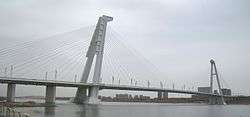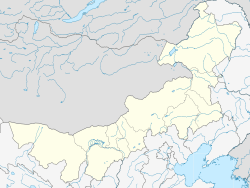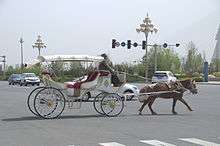Kangbashi District
Kangbashi District, also known by its Mongolian name Hia Bagx District or Hia'bagx District, is an urban district of the prefecture-level city of Ordos in Inner Mongolia, China.
Kangbashi District 康巴什区 • ᠬᠢᠶᠠᠪᠠᠭᠰᠢᠳᠤᠭᠤᠷᠢᠭ | |
|---|---|
District | |
 Kangbashi Bridge | |
 Kangbashi District Location in Inner Mongolia | |
| Coordinates: 39°35′49″N 109°47′28″E | |
| Country | People's Republic of China |
| Autonomous region | Inner Mongolia |
| Prefecture-level city | Ordos |
| Area | |
| • Urban (2018)[1] | 233 km2 (90 sq mi) |
| Population | |
| • Urban (2018)[2] | 200,000 (Including Ejin Horo) |
| Time zone | UTC+8 (China Standard) |
| Kangbashi District | |||||||||||||||||
|---|---|---|---|---|---|---|---|---|---|---|---|---|---|---|---|---|---|
| Chinese name | |||||||||||||||||
| Simplified Chinese | 康巴什区 | ||||||||||||||||
| Traditional Chinese | 康巴什區 | ||||||||||||||||
| Hanyu Pinyin | Kāngbāshí Qū | ||||||||||||||||
| |||||||||||||||||
| Mongolian name | |||||||||||||||||
| Mongolian Cyrillic | Хиа багш дугариг | ||||||||||||||||
| Mongolian script | ᠬᠢᠶᠠ ᠪᠠᠭᠰᠢ ᠳᠤᠭᠤᠷᠢᠭ | ||||||||||||||||
| |||||||||||||||||
The district is internationally known for its opulent civic square and monuments and for having few residents relative to the grandeur of the built-up space that was financed by the Chinese government.[3] The number of the residents has risen slightly since the district was first constructed.[3]
Geography
Within the Ordos prefecture, the district is located southwest of Dongsheng, the prior urban center of Ordos, and north of Ejin Horo Banner. Adjacent to the south is Altan Xire, the highly urbanized county seat of Ejin Horo Banner, separated from the district by the Wulan Mulun River.
History
With an expanding district due to economic exploitation of the local natural resources, but dwindling water supplies due to the continual expansion of the Ordos Desert, Ordos officials were faced with a local infrastructure planning problem. Hence in 2003, Ordos city officials launched the creation of a new 1 million person city district. Located on a 355-square-kilometre (137 sq mi) site 25 kilometres (16 mi) from the existing city of Dongsheng, the new city is located next to three existing reservoirs on the site of two former villages.[4]
As of 2010, the current city on a site of 35 square kilometres (14 sq mi) has capacity for at least 300,000 people, created with an estimated investment of around 1.1 trillion yuan ($161 billion).[5]
Economy

There is a campus of Beijing Normal University and a municipal library. A five-story shopping mall offers a food court and other shopping. A large "fountain show" provides evening entertainment.[6] Economic activity is gradually picking up with the help of the local government which has relocated its administrative center and high quality high schools here. A documentary has been produced by outside filmmakers which documents the facilities of the city and its gradual growth.[7]
Apartment and office capacity
Characterized as a ghost town, Kangbashi was made world-famous by a news report in November 2009 from Al Jazeera,[8] later picked up and expanded through an April 2010 article in Time magazine,[9] for having few residents but massive amounts of empty residential housing and high-tech public works projects. Subsequent reports have supported the claims that Kangbashi housed around 20,000 to 30,000 people as of 2010.[10] A joint Peking University and Baidu study in 2015 found high vacancy rates in parts of Kangbashi.[11]
Transportation
- China National Highway 210
- Ordos Airport
See also
- Yujiapu Financial District, another Chinese city built from scratch
- Kilamba, an initially empty Chinese-built city in Angola
- Spatial mismatch
References
- Cox, W (2018). Demographia World Urban Areas. 14th Annual Edition (PDF). St. Louis: Demographia. p. 82.
- Cox, W (2018). Demographia World Urban Areas. 14th Annual Edition (PDF). St. Louis: Demographia. p. 82.
- Jody Rosen (March 6, 2015). "The Colossal Strangeness of China's Most Excellent Tourist City". The New York Times Style Magazine. Retrieved March 9, 2015.
- Hu Yinan (10 June 2010). "Ghost town". China Daily. Retrieved 2010-11-13.
- "China's Desert Ghost City Shows Property `Madness' Persists". Bloomberg News. Jun 23, 2010. Retrieved 2010-11-13.
- Jody Rosen (March 6, 2015). "The Colossal Strangeness of China's Most Excellent Tourist City". The New York Times Travel Magazine. Retrieved March 9, 2015.
It’s nice here,” said one of the women. “My hometown is a tiny place in the grassland. The people here are more well educated. There’s so much more to do here.” What is there to do in Ordos? “I hang out with my friends. We study at the library. We go to the mall.
- Eli Bildner (April 8, 2013). "Ordos: A Ghost Town That Isn't In this interview, two documentary filmmakers profile the surprising liveliness of Ordos, a Chinese city famous for its emptiness". TeaLeafNation via Atlantic. Retrieved March 9, 2015.
The government has moved its officials into the new town, and they've also moved some of the city's best schools into the new town, to try to bring in young people.
- "China's Ghost Town". Al Jazeera. 10 November 2009. Retrieved 2010-12-21.
- Bill Powell (April 5, 2010). "Inside China's Runaway Building Boom". Time magazine. Retrieved 2010-12-21.
- Robert Peston (11 November 2010). "China: boom or bust?". BBC News. Retrieved 2010-11-13.
- Baidu found China’s “ghost cities,” but it is keeping their locations mostly a secret